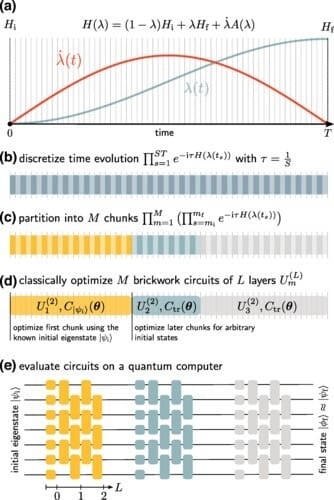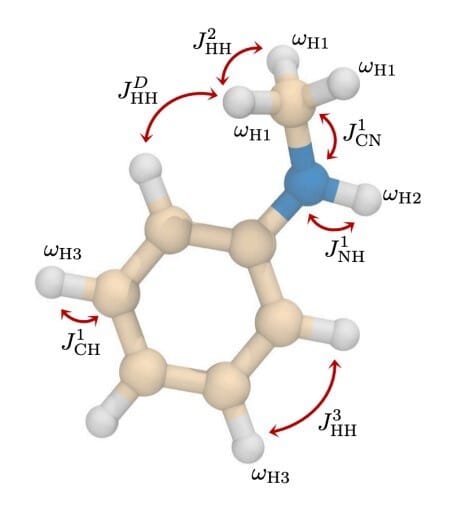- The Daily Qubit
- Posts
- The Daily Qubit
The Daily Qubit
🔥 Hot Quantum Summer is on with weather prediction, wearable brain scanners, underground mapping solutions, and NMR spectroscopy

Welcome to the Quantum Realm.
👠 Toto, we’re not in Kansas anymore — quantum is reducing computational cost of weather predictions. Coming to you from tornado valley, we like the sound of that. 🌪️
🗓️ THIS WEEK
Wednesday, June 5 - Friday, June 14 | IBM Quantum Challenge 2024 — Register here!
Saturday, June 15 | Simulation of Quantum Chemistry Hamiltonians with Relativistic Effects w/ Washington DC Quantum Meetup
📰 NEWS QUICK BYTES
🌪️ Quantum for Weather: Researchers from Chiba University debut a quantum algorithm to reduce the computational cost of weather prediction data assimilation using quantum annealing.
🎮️ Quantum Control as the Key to Scaling: McKinsey Digital reports on quantum control challenges in qubit manipulation, highlighting innovations needed in noise reduction, measurement precision, and scalability to achieve fault-tolerant quantum systems.
🏢 The Case for On-Prem Quantum: Yuval Boger of QuEra Computing highlights the benefits of on-prem quantum installations for control, data security, and reduced latency, recommending a hybrid approach with cloud resources as the technology matures.
🔐 PQC for a Quantum-Safe Future: Frederic Jacquet highlights the need for post-quantum cryptography, it’s challenges with implementation, and NIST's pilot projects and educational programs as a key to integrating PQC into existing systems.
🎲 UK Bets on Commercial Quantum: The UK government commits £2.5 billion over ten years to support quantum startups, with a goal to reach commercial viability by 2033. Notable ventures include Cerca Magnetics, which has developed a wearable brain scanner, and Delta.g, which offers underground mapping solutions.
💾 Listen to this primer on quantum computing from Deloitte's Scott Buchholz. He breaks down its differences from traditional computing, potential use cases, and associated risks.
🕸️ Watch this interview with Dr. Paul Terry, CEO of Photonic Inc., as he discusses the potential of quantum computing, the industry's evolution, and Photonic's distributed quantum technology.
☕️ FRESHLY BREWED RESEARCH
Towards Adiabatic Quantum Computing Using Compressed Quantum Circuits: A method for optimizing quantum circuits in adiabatic quantum computing uses tensor network algorithms and variational matrix product operators to incorporate counterdiabatic driving and improve ground-state preparation fidelity and efficiency compared to traditional Trotter formulas. This approach reduces circuit depth. Breakdown here.
Prospects for NMR Spectral Prediction on Fault–Tolerant Quantum Computers: Using fault-tolerant quantum computers to simulate NMR spectra in the zero-to-ultralow field regime can reduce computational complexity and costs associated with interpreting complex NMR spectra. Breakdown here.
Many-excitation removal of a transmon qubit using a single-junction quantum-circuit refrigerator and a two-tone microwave drive: The use of a single-junction quantum-circuit refrigerator combined with a two-tone microwave drive expedites the removal of excitations from a transmon qubit. This improves qubit reset times and is validated by a detailed theoretical model.
Investigate the Performance of Distribution Loading with Conditional Quantum Generative Adversarial Network Algorithm on Quantum Hardware with Error Suppression: The performance of a conditional quantum generative adversarial network is explored for distribution loading on IBM's quantum hardware using the Fire Opal error suppression system. Results show that Fire Opal enhances the accuracy of the generated distributions by 30-40% compared to simulations without error suppression.
Exploring thermal equilibria of the Fermi-Hubbard model with variational quantum algorithms: Variational quantum algorithms are used to study the thermal properties of the Fermi-Hubbard model, emphasizing the optimization of these algorithms to address coherence constraints in quantum hardware. The research demonstrates that physics-inspired circuit designs can effectively capture the behavior of materials at elevated temperatures, although the gapless nature of the Fermi-Hubbard model requires substantial resources to explore larger lattice systems.
Applications of model-aware reinforcement learning in Bayesian quantum metrology: Model-aware reinforcement learning is applied to Bayesian quantum metrology and demonstrates an ability to optimize adaptive estimation tasks for quantum sensors. The proposed techniques are implemented in the qsensoropt library for broader use.
UNTIL TOMORROW.
How many qubits was today's newsletter? |
BREAKDOWN
Towards Adiabatic Quantum Computing Using Compressed Quantum Circuits
🔍️ SIGNIFICANCE:
This addresses the optimization of quantum circuits for adiabatic quantum computing, which is foundational for several quantum algorithms and devices, such as the D-Wave quantum annealer and the quantum approximate optimization algorithm. Adiabatic quantum computing relies on slowly evolving a quantum system from an initial ground state to the ground state of a problem Hamiltonian, which encodes the solution to the computational problem. This process is successful if the evolution is slow enough to maintain adiabaticity, a condition that becomes increasingly challenging as the system size grows.
The traditional approach to implementing adiabatic evolution on digital quantum computers involves using Trotter product formulas, which discretize the time evolution into a sequence of quantum gates. However, the inclusion of counterdiabatic driving, which helps suppress unwanted transitions and improve fidelity, increases the circuit depth. The research introduces a method where a parameterized quantum circuit of fixed depth is classically optimized to capture both adiabatic evolution and counterdiabatic driving. This approach not only reduces the circuit depth but also maintains high fidelity over many time steps and outperforms traditional Trotter product formulas.
🧪 METHODOLOGY:
Tensor network algorithms are used to optimize quantum circuits for adiabatic quantum computing. Specifically, they use a variational matrix product operator ansatz to represent adiabatic gauge potentials.
The MPO ansatz is numerically optimized using a variational procedure that minimizes a cost function and allows the approximation of the AGP with high accuracy.
Instead of increasing the circuit depth with additional counterdiabatic terms, the researchers optimize a parameterized quantum circuit of fixed depth. This circuit is designed to capture the adiabatic evolution and counterdiabatic driving over short time intervals, and then concatenated to represent the entire evolution.
The classical optimization of the quantum circuit is done in segments, where each segment is optimized independently to handle the counterdiabatic dynamics effectively. This iterative process allows for the construction of a sequence of circuits that can be executed on a quantum computer.
This methodology is applied to the ground-state preparation of quantum Ising chains with transverse and longitudinal fields to show improvements in ground-state fidelities and energy accuracies compared to traditional Trotter circuits. Additionally, the approach is discussed for potential use in combinatorial optimization problems.
📊 OUTCOMES & OUTLOOK:
The classically optimized PQCs significantly outperform traditional Trotter circuits in preparing the ground state of quantum Ising chains. The ground-state fidelities are improved by a factor of 5, and energy accuracies by a factor of 3.
It’s shown that shallow quantum circuits, optimized using tensor network methods, can achieve high accuracy in adiabatic quantum computing tasks without the need for deep and complex circuits. This is especially important for current quantum hardware, which is limited by coherence times and gate fidelities.
The research indicates that the same methodology can be extended to combinatorial optimization problems, which are of significant interest in both quantum computing and classical optimization. The ability to optimize quantum circuits for such problems using classical pre-processing techniques could lead to more practical and scalable quantum algorithms.
Source: McKeever, Conor and Lubasch, Michael. Towards Adiabatic Quantum Computing Using Compressed Quantum Circuits. PRX Quantum. (2024). https://doi.org/10.1103/PRXQuantum.5.020362
BREAKDOWN
Prospects for NMR Spectral Prediction on Fault–Tolerant Quantum Computers
🔍️ SIGNIFICANCE:
NMR spectral prediction using quantum computers has the potential to revolutionize how we interpret complex NMR spectra, especially where the zero-to-ultralow field is involved. Conventional NMR spectrometers, which rely on high magnetic fields, are limited by high costs and infrastructure requirements. Recent advances in atomic magnetometry allow NMR spectroscopy at much lower field strengths, which can mitigate relaxation effects and reveal detailed spin couplings. However, interpreting these spectra computationally is challenging due to the complexity of long-range spin interactions.
🧪 METHODOLOGY:
Fault-tolerant quantum computers are used to simulate NMR spectra, with a focus on the ZULF. Algorithms for quantum dynamics, specifically quantum signal processing and quantum eigenvalue transform are used to construct explicit quantum circuits.
These circuits are designed to simulate the time evolution of spin systems described by Heisenberg Hamiltonians. The research includes optimizing encodings to reduce resource requirements and compressed sensing techniques for efficient spectral reconstruction.
The methodology uses a combination of qubitized quantum dynamics and optimized block encoding strategies to handle the non-unitary Hamiltonians inherent in NMR simulations.
📊 OUTCOMES & OUTLOOK:
The key findings indicate that fault-tolerant quantum computers can simulate ZULF NMR spectra for a wide range of high-value molecular targets with with relatively modest overhead.
This approach could make NMR spectroscopy more accessible and affordable, which is relevant to its application in fields like chemistry, medicine, and materials science.
Source: Justin E. Elenewski and Christina M. Camara and Amir Kalev. Prospects for NMR Spectral Prediction on Fault-Tolerant Quantum Computers. arXiv quant-ph. (2024). https://doi.org/10.48550/arXiv.2406.09340
Support Science
Waking up before the world to dive into the quantum realm isn't just our job—it's our calling. And we're dreaming big with exclusive content for our community. If our work lights up your day, consider showing some love. Your support unlocks worlds—seen and unseen.
Interested in collaboration or promoting your company, product, job, or event to the quantum computing community? Reach out to us at [email protected]


